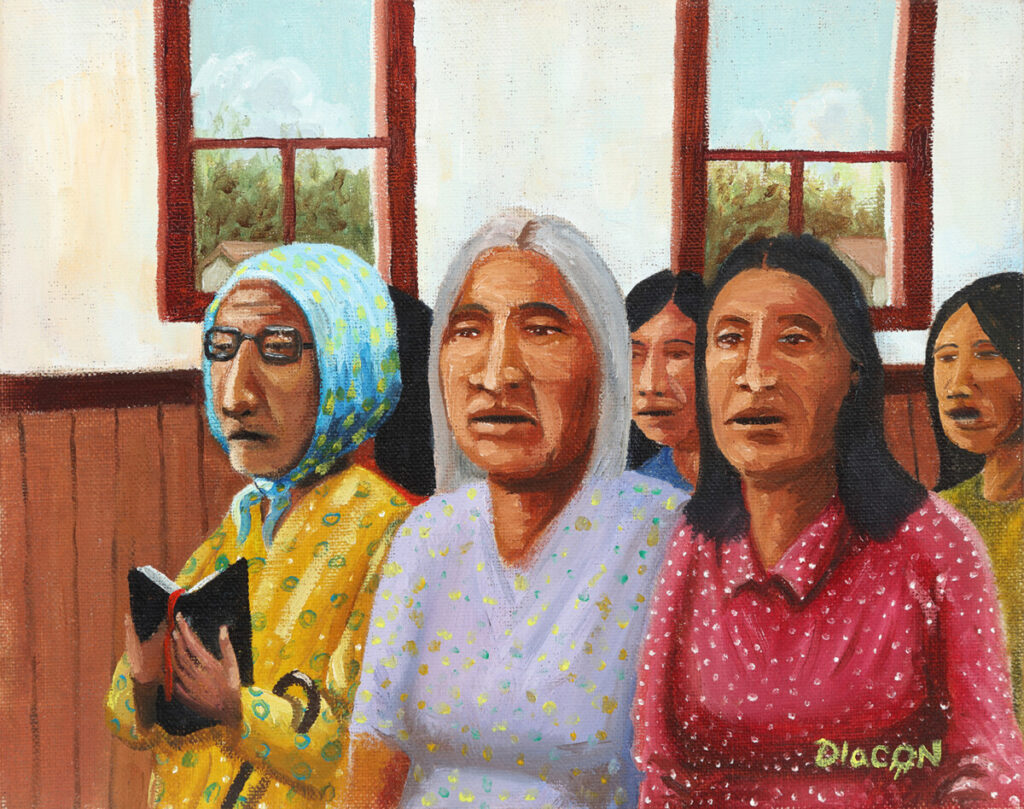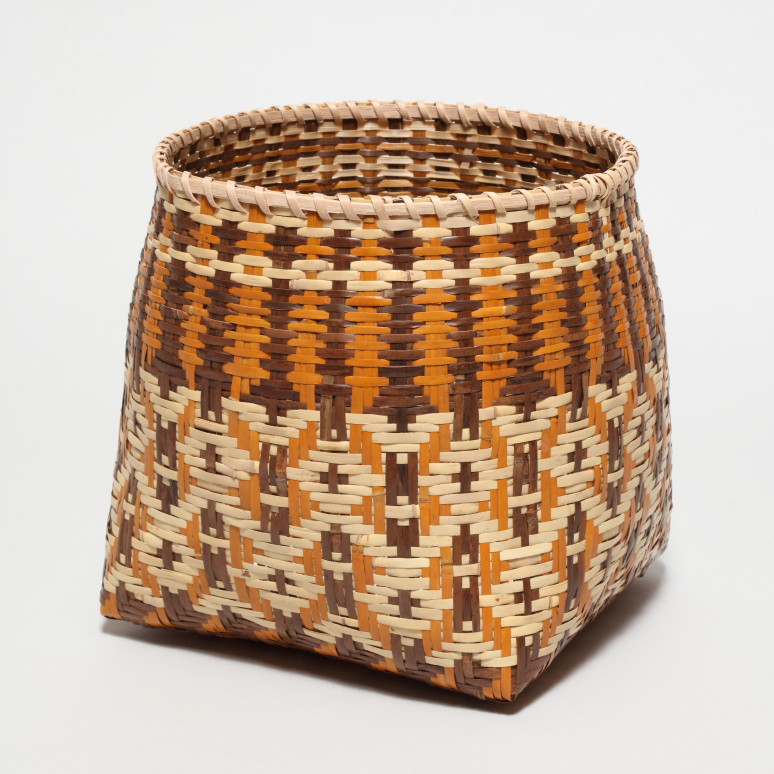Colorful works by Indigenous artists await Atlanta audiences and the Emory community when Emory Libraries opens the exhibition “This Land Calls Us Home: Indigenous Relationships with Southeastern Homelands.”

“Mvskoke Church Women,” 2019, by Johnnie Lee Diacon (Muscogee Creek). Oil on stretched linen.
The exhibition, which opens Monday, Jan. 27, in the Schatten Gallery on Level 3 of Emory’s Robert W. Woodruff Library, will feature the work of 25 contemporary Native American artists and designers. More than 50 pieces will be on display that express Southeastern Indigenous heritage, including textiles, photographs, paintings, intricate woven baskets and more.
The opening event will begin with remarks at 7 p.m. in the rotunda followed by walking tours of the exhibition and a reception. The exhibit and the opening event are both free and open to the public.
Timelines of the intertwining history of early Emory University and the federal removal of Native American populations from the southeastern United States will be on display in the corridor gallery. The timelines include research from a variety of sources, as well as some research from Emory faculty and students and images from Emory University Archives.
“These creative works by Indigenous artists are an authentic voice exploring the relationship of Native peoples with their homelands in the Southeast,” says Lisa Macklin, associate vice provost and university librarian. “This exhibit will expand our collective understanding of Indigenous peoples and their contemporary relationships with their ancestral homelands. It celebrates resilience while recognizing painful and difficult histories.”
Macklin says this exhibit connects with the ongoing work Emory University is doing with the Twin Memorials project, the Indigenous Language Path Working Group, the Center for Native American and Indigenous Studies and other projects, as the university comes to terms with its origins in 1836 on Native lands taken by the U.S. government 15 years earlier.
Macklin hopes “This Land” inspires students in the Native American and Indigenous Studies Initiative and in other courses of study to discover new knowledge in Native American history and contemporary Indigenous life.
“It provides a space for all of us to contemplate belonging, social justice, healing, and transformation. We invite both the Atlanta metro community and the Emory community, especially students, to join us for this powerful experience,” she says.
‘This Land’ history
“This Land Calls Us Home” was previously on view in the art gallery space of the T North Concourse at the Hartsfield-Jackson Atlanta International Airport, where it was viewed by tens of thousands of visitors. It is presented by the General Board of Global Ministries of The United Methodist Church (UMC), in collaboration with the UMC’s Native American Comprehensive Plan.

“River Cane Basket, 2019,” by Vivian Garner Cottrell (Cherokee). Woven river cane.
Mekko (Rev.) Chebon Kernell (Seminole/Muscogee) originally conceptualized this exhibition for the Atlanta airport last year. He is an ordained elder in the Oklahoma Indian Missionary Conference and executive director of the Native American Comprehensive Plan for the United Methodist Church.
“I believe it is vital for the community of Emory University to continue the journey of educating itself about the historical and contemporary presence of Mvskoke (Muscogee) people and the greater Indigenous community of the area,” says Kernell. “This exhibition assists in the endeavor of erasing an intentional historical silencing that has been inflicted upon the stories of this country’s Indigenous peoples communities. In our day and time, it is crucial to use every opportunity possible to teach about the truth, survival and presence of the Native American people of the United States.”
The work on Emory’s history
“On Remembering, Return, and Responsibility” is a corridor gallery exhibit presented with the “This Land” exhibition. It features two timelines: one tracing the dispossession of southeastern Indigenous lands and the conflicts as European settlers moved in, and the other outlining Emory University’s growth from its origins on Muscogee (Creek) Nation land in Oxford, Georgia, to current efforts to reckon with its history.
Miranda Kyle, the Michael C. Carlos Museum’s curator of Indigenous Arts of the Americas and a Cherokee descendant, advised on the original iteration of “This Land,” oversaw the re-installation of the exhibition in the Schatten Gallery, and curated the timeline walls in the corridor gallery.
“This exhibition is so joyful, while still talking about very serious topics,” Kyle says. “It celebrates the resilience of the Indigenous peoples who call the Southeast home. I think that’s something that Emory is aspiring to – how do we become a center for serious study in research, but that also holds on to and perpetuates joy? And in the times that we live in now, that is extremely important.”
“This Land Calls Us Home” comes at a time when the university is grappling with its early history.
In recent years, Emory has held annual collaborative Muscogee Teach-ins; co-hosted (with Emory Libraries) a symposium in 2021 called “In the Wake of Slavery and Dispossession” that focused on continuing efforts and research into slavery, dispossession and restorative justice; and launched initiatives such as the Task Force on Untold Stories and Disenfranchised Populations and its projects like the Indigenous Language Path Working Group and the Twin Memorials project to acknowledge the university’s history with enslaved labor and relationships to lands where Indigenous people originally lived.
The timelines include these projects, as well as research conducted by Emory faculty and students, such as projects by author and filmmaker Malinda Maynor Lowery, an American history and Native American and Indigenous Studies professor; and Mike Mortimer, a 2022-2024 provost’s postdoctoral fellow in Native American history. Mortimer led the student-driven 1836 Project about Emory’s early days in the Oxford area and the forced removal of Cherokee and Muscogee peoples in the area 15 years earlier. An interactive kiosk in the corridor exhibit will allow visitors to explore the 1836 Project.
“Particularly with the timeline walls, we’ll be pulling from Emory faculty and scholar research, and that will provide an opportunity to see the work that Emory has been doing in the last 10 years or so. We’re building on the scholarship of other people,” Kyle says.
“This Land Calls Us Home” will be on display Jan. 27 – July 20, 2025, in the Schatten Gallery on Level 3 of the Robert W. Woodruff Library (540 S. Asbury Cir., Atlanta, GA 30322). The exhibition is free and open to the public. Check the hours webpage before visiting. For more information, visit the exhibitions webpage.
—by Maureen McGavin, Emory Libraries senior writer
Exhibition details
“This Land Calls Us Home: Indigenous Relationships with Southeastern Homelands”
Jan. 27 – July 20, 2025
Schatten Gallery, Level 3 of Emory University’s Woodruff Library
540 S. Asbury Cir., Atlanta, GA 30322
Free and open to the public
Check hours
Related events (free and open to the public)
Opening event for “This Land Calls Us Home”
Monday, Jan. 27, 2025, 7-8:30 p.m.
Opening remarks followed by guided walking tours
Schatten Gallery, Woodruff Library Level 3
Register
Film screening of ᏓᏗᏬᏂᏏ (Dadiwonisi / We Will Speak)
with the filmmakers, to include commentary and Q&A session
June 2025 (date/time TBD)
Jones Room, Woodruff Library Level 3
This documentary explores the nuanced ways the Cherokee language is vital to maintaining a unique cultural identity and relationship with the world.
Related links:
Research Guide for Native American and Indigenous Studies
Related stories
New Center for Native and Indigenous Studies set to launch in fall 2023
Muscogee Teach-In joins Indigenous and Emory communities in language and dance
U.S. Poet Laureate Joy Harjo gives free Emory University reading online (2021)
